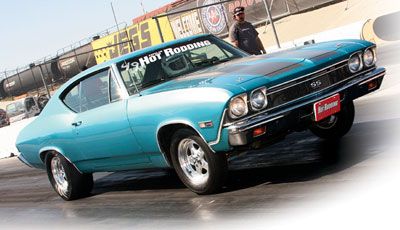
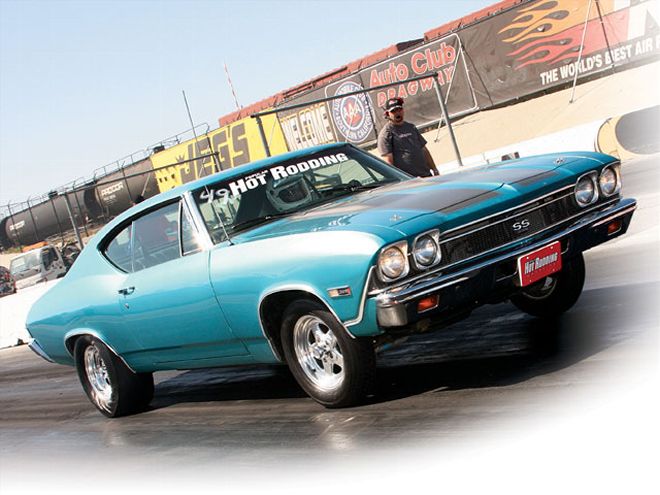
Street SweeperTo a lot of hot rodders, ourselves included, a performance torque converter is just another check mark to tick on the to-do list of building a fast street car. You bolt it on, and promptly forget about it. There it spins quietly out of sight under your car, while the other high-profile parts like the engine, wheels, and paint get all the attention. If you've done your homework, and had all the right discussions with your engine builder and your torque converter manufacturer, you should be good to go for 90 percent of the street applications.
Your torque converter has an intimate relationship with your engine; the final torque output of the transmission is the mathematical product of the engine's torque peak multiplied by the torque multiplication of the torque converter. The idea is to have a torque converter that flashes near the point where your engine makes peak torque. Get the relationship of the torque converter stall speed to the power curve right, and you'll see Elvis at the 60-foot mark. Get it wrong, and you'll see pavement moving very slowly.
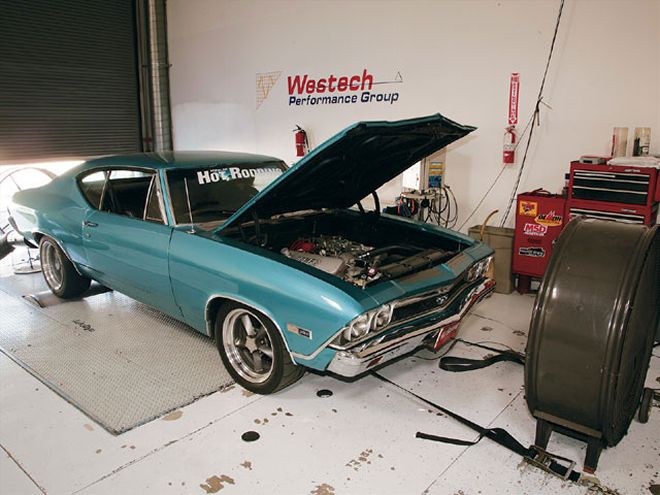 Our story begins with a chassis dyno test we performed on our '68 Chevelle at Westech Performance Group. Last month, we addressed some issues we had with pulley and belt alignment, and took that opportunity to reduce some parasitic drag. Before all that, we posted a peak horsepower reading of 419 hp at 5,750 rpm. After that test, we swapped the solid fan spacer for a more efficient clutch fan, we tossed the stock alternator pulley for a 4-inch underdrive piece, and we swapped the loose TCI Super StreetFighter converter for the tighter StreetFighter converter. After performing another jetting and timing loop, we bagged another 29 rear-wheel horsepower for a total of 448 (at 5,800 rpm).
Our story begins with a chassis dyno test we performed on our '68 Chevelle at Westech Performance Group. Last month, we addressed some issues we had with pulley and belt alignment, and took that opportunity to reduce some parasitic drag. Before all that, we posted a peak horsepower reading of 419 hp at 5,750 rpm. After that test, we swapped the solid fan spacer for a more efficient clutch fan, we tossed the stock alternator pulley for a 4-inch underdrive piece, and we swapped the loose TCI Super StreetFighter converter for the tighter StreetFighter converter. After performing another jetting and timing loop, we bagged another 29 rear-wheel horsepower for a total of 448 (at 5,800 rpm).
Where most guys get it wrong is in estimating the flash speed of the converter. If your peak engine torque occurs at 3,800 rpm like our Chevelle's 496, it may be tempting to order a converter with a 3,800 stall-the stall number in this case being merely a benchmark, not an empirical figure. The error comes into play because the stall speed of a converter is actually determined by the engine's torque and the weight of the vehicle. What may be a 3,800 stall speed in a 3,000-pound Camaro with a small-block may actually be a 5,000 stall in a 3,800-pound Chevelle with a big-block. At this point, it's important to note that a guy with a hot street car that is seldom raced may not even notice a mismatch, or even feel that anything is off. We certainly didn't. In the case listed above, we may be splitting hairs, but if you're at the track every weekend, or even a couple of times a year, you stand to gain some serious e.t. by fine-tuning your converter's stall speed. In fact, many builders of high-end, high-performance torque converters give their customers one free converter adjustment, because it is so very important, and because it is so elusive to guess correctly on the first try.
Converter stall speed is often referred to as a "tightness" or "looseness," because in the early days of performance converters, the most common method of changing the stall speed was by adjusting the running clearance (tighter or looser) between the two halves of the converter, known as the impeller (the driving side) and the turbine (the driven side). This had the desired effect of altering the stall speed, but with one nasty, seldom talked-about downside-a huge penalty in efficiency, and hence, torque multiplication. In the old days, you'd see torque converters for sale for $99-and that's the game that was being played there. You would be better off visualizing one of these cheap converters as a huge power soak for your engine!
A lot more is known about torque converter technology today, and much of this has been pioneered by TCI Automotive. At TCI, a variety of techniques are employed to arrive at the correct stall speed. While the clearance between the impeller and turbine is still a proven method of fine-tuning stall speed, TCI also makes adjustments to the pitch of the fins in the turbine, and/or the impeller, depending on the application. But perhaps the biggest advance has been in the design and modification of the stator-the small donut in the converter's center. The stator, though small, is responsible for the overall efficiency and torque multiplication of the converter during acceleration. Changing the number of blades or their clearance has a profound effect on the stall speed and overall torque multiplication. TCI has all these bases covered, and it's for this reason we initially turned to them for the Super StreetFighter converter in our '68 Chevelle.
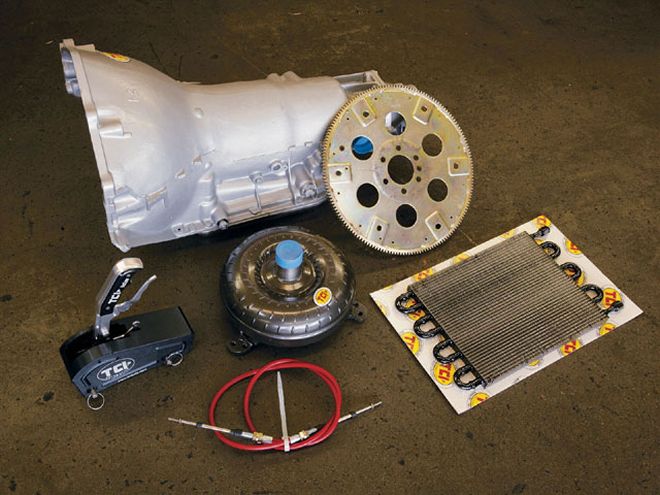 In review, the drivetrain of our big-block '68 Chevelle consists of TCI's Super StreetFighter Turbo 400 trans, TCI Outlaw shifter, TCI SFI-spec flexplate, TCI trans cooler, and our initial Super StreetFighter torque converter with a stall rating of 3,800-4,000 rpm. This got us to a best of 11.41/114.9, but we were launching well through the converter's rated stall (4,900 rpm), and losing valuable horsepower in the deal. Did TCI have anything tighter for us?
In review, the drivetrain of our big-block '68 Chevelle consists of TCI's Super StreetFighter Turbo 400 trans, TCI Outlaw shifter, TCI SFI-spec flexplate, TCI trans cooler, and our initial Super StreetFighter torque converter with a stall rating of 3,800-4,000 rpm. This got us to a best of 11.41/114.9, but we were launching well through the converter's rated stall (4,900 rpm), and losing valuable horsepower in the deal. Did TCI have anything tighter for us?
Our initial selection of TCI's Super StreetFighter converter (PN 241002 for a Turbo 400, $474.99 through Jegs) was based on TCI's recommendation for a big-block making peak torque between 3,800 and 4,000 rpm. All of our initial drag testing was performed with the Super StreetFighter, and on every launch we pretty much blew right through that 4,000-rpm stall ceiling, hitting close to 5,000 rpm. To be honest, it felt great, and netted us 60-foot times as quick as 1.55 seconds. On the street, we could pretty much lay rubber at will. Highway driving wasn't a strong suit, however, as the converter would easily flash 1,000 rpm in passing situations. In all honesty, as a street car it could've gone either way, but we were hungry for e.t. and suspected there was something to be found in our choice of converters.
In two sessions of drag tests and in two different chassis dyno test sessions, we were able to rule out the cause of our lackluster trap speed due to fuel starvation. We also reduced the parasitic drag on the engine with an underdrive alternator pulley and a clutch fan arrangement. We also corrected a partially opening secondary throttle, and improved our rear-wheel power through a series of jetting and ignition tuning loops. The only thing remaining, it seemed, was to look at our unusually high flash speed at launch.
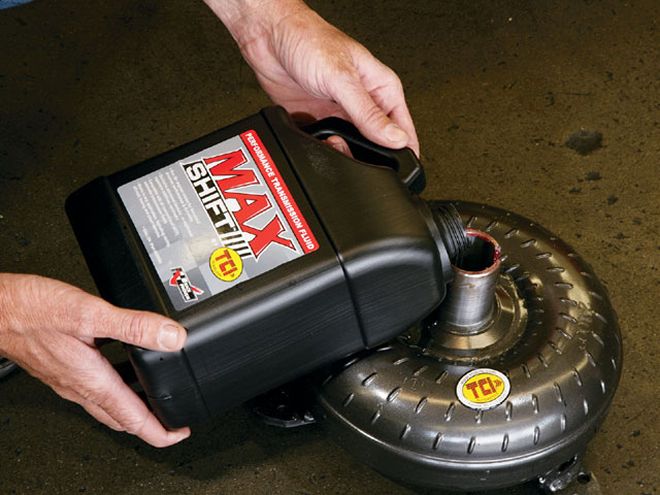 Yes! TCI does have what we need, in the form of a tighter StreetFighter model (PN 241001). One key feature that we wanted to retain from the Super StreetFighter was the antiballooning plates, which prevent the fluid pressure from forcing the two halves of the converter apart (and losing torque) during launch. A hardened pump hub also withstands the reaction force of the stator without breaking or galling. Furnace-brazed fins prevent deflection (and loss of torque) at launch, and needle bearing thrust surfaces reduce friction and wear. TCI recommends its Max Shift fluid, and we obliged. We haven't been let down by it yet.
Yes! TCI does have what we need, in the form of a tighter StreetFighter model (PN 241001). One key feature that we wanted to retain from the Super StreetFighter was the antiballooning plates, which prevent the fluid pressure from forcing the two halves of the converter apart (and losing torque) during launch. A hardened pump hub also withstands the reaction force of the stator without breaking or galling. Furnace-brazed fins prevent deflection (and loss of torque) at launch, and needle bearing thrust surfaces reduce friction and wear. TCI recommends its Max Shift fluid, and we obliged. We haven't been let down by it yet.
Like we said earlier, many guys get it wrong when it comes to estimating the stall speed of their converter. There's no shame in this-it happens all the time. Most racers make tweaks to the stall speed at least once, and sometimes several times, and we were about to do the same. We put a call in to the tech support line at TCI (888-776-9824), and discovered that they had what we needed as a stocked part already on the shelf. Normally we might send our converter back, have it tightened, then reinstall it, but this gave us the luxury of keeping the Street Sweeper Chevelle on the road so that we could make a near simultaneous seat-of-the-pants comparison. For the moment, we kept driving our Super StreetFighter while waiting for our new unit, which was TCI's StreetFighter (PN 241001, Jegs price $444.99).
While this StreetFighter converter technically is one notch down from the Super StreetFighter in the hierarchy at TCI, it's actually constructed with the same hard-core components. In both, you'll find furnace-brazed fins, needle bearings instead of thrust washers, a hardened preground pump hub, computer balancing, and antiballooning plates. Both are built from 10-inch cores too, so there's not a lot of difference in the strength or outward appearance. What you will find is that the StreetFighter has a stall rating (for a big-block) in the 3,400-3,600-rpm range. The important thing here is that the stall range is 400 rpm less than the Super StreetFighter. With 635 lb-ft of torque turning on at 3,800 rpm, our 496 is going to force the stall speed of most street-type converters beyond their rated range. If we saw 4,500 rpm at launch out of the tighter converter, we'd surely see a vast improvement on the e.t. clocks.
When the tighter StreetFighter came, we pulled the old one, poured in some more TCI Max Shift fluid to make up the deficit, and hit the road. The difference was immediate and dramatic. As good as the last converter felt, the tighter TCI turned on faster, sooner, and harder. How could it not make a positive difference at the track? We'd soon find out.
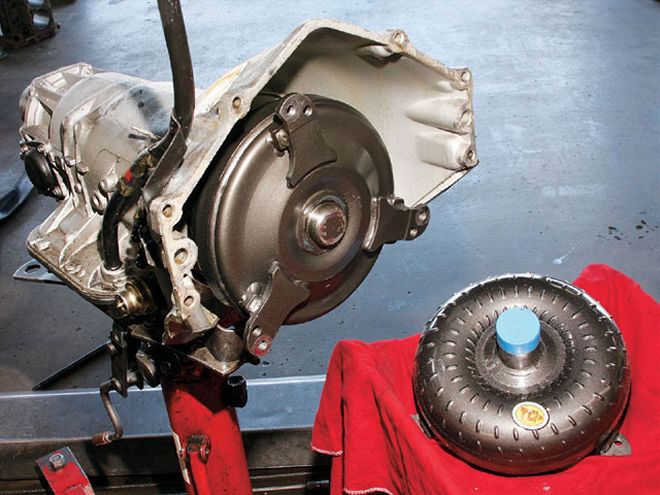 Visually, our old TCI Super StreetFighter (PN 241002) looks the same as the tighter StreetFighter (PN 241001). Both come with the same internal construction and are built on 10-inch cores. The difference: our new StreetFighter is tighter, with a 400-rpm lower stall speed (3,400-3,600 versus 3,800-4,000) and costs about $30 less. The cost difference, we're told, has more to do with the size of TCI's total build order, not any difference in materials.
Visually, our old TCI Super StreetFighter (PN 241002) looks the same as the tighter StreetFighter (PN 241001). Both come with the same internal construction and are built on 10-inch cores. The difference: our new StreetFighter is tighter, with a 400-rpm lower stall speed (3,400-3,600 versus 3,800-4,000) and costs about $30 less. The cost difference, we're told, has more to do with the size of TCI's total build order, not any difference in materials.
We were back at Fontana's quarter-mile the day before Easter. We got there early, bolted on the 10.5x28 Mickey Thompson slicks, aired them down to our normal 14 psi, threw the skinnies on, set the driver-side Air Lift bag to zero psi and put the right one at 15 psi, clicked the QA1 Stocker Star rear shocks to setting "3," and hit the staging lanes. And then one of the most amazing strings of wrecks and oil downs we've ever seen ensued. Sometimes a day at the track goes really well, and other times you're at the other end of the bell curve, and this was one of those days. Fortunately, none of the bad luck on the track involved us, and we did squeeze in two runs within a 10-hour period. On the first one, we lifted at the 1,000-foot mark (we have no rollbar and had previously gone too deep into the 11s), and got a 7.19/94.7 in the eighth-mile with a 1.59 60-foot time. The trap speed was the quickest we'd ever posted in the eighth, and that's the indicator we were most concerned with here.
Trap speed is the measure of applied horsepower, even more so than e.t. It's also the best way for us to judge converter efficiency, and we could clearly see we were on to something: Our best previous trap speed had only been 94.3 mph, and we just went 94.7 on the first run. We thought we'd have at least three or four more passes to test things out, but the ambulance began to resemble a meat wagon, making runs to the hospital every hour or so. Multiple cleanups without adequate equipment or trained personnel also tagged us for several wasted hours (not to mention some lost 60-foot time). When we finally got a chance to make a run, it was a single balls-out quarter-mile. Like the first run, the launch was clean, and the tach flashed to 4,400 rpm on the launch, much lower than the 4,900-5,000 we'd been getting with the looser Super StreetFighter. That was a lot closer to our torque peak, and it showed up in the e.t. and trap speed: a best run ever for the Street Sweeper Chevelle with a 11.30 at 117 mph (7.14/95.1 in the eighth). Like all the runs prior, we shifted manually at 5,800 rpm to keep things on the safe side.
We got the magic number we were looking for: 117 mph in the quarter. We've been shooting for that because it's our best educated guess as to what our 3,666-pound Chevelle should be running at 1,100-feet altitude with full accessory dress and approximately 620 hp at the flywheel. We think with a few more runs it could've gone even faster, but that's a story for another month.
Right now, we're turning our attention to the high price of pump gas and how we might be able to cope a little better with that. Next month, we'll be headed down to Gear Vendors for one of their electronic overdrive units. We'd love to get the gas mileage of the Street Sweeper Chevelle back into the double-digit range before the gas bill kills us!
Street Sweeper Chevelle
Drag Test Results
All runs shallow staged, converter flashed to 3,000 rpm, manual shift at 5,800 rpm, right rear airbag filled preloaded to 15 psi, single-adjustable QA1 rear shocks set to position "3."
SESSION TWO-JANUARY 18, 2008* 60-FT: 1/8 1/8 1/4 1/4 E.T.: MPH: E.T.: MPH: NOTES: 1.57 7.19 94.1 11.41 114.9 28x10.5 ET Drag slick, "slow it down boy, or you're outta here!" 1.55 7.16 94.0 12.18 81.4 28x10.5 ET Drag slick, lifted after half track 1.58 7.21 91.2 12.72 75.3 28x10.5 ET Drag slick, lifted after half track 1.57 7.22 93.5 11.87 92.8 28x10.5 ET Drag slick, lifted at 1,000 ft. 1.57 7.18 94.3 11.72 95.9 28x10.5 ET Drag slick, lifted at 1,000 ft. 1.55 7.16 94.1 11.94 98.4 28x10.5 ET Drag slick, lifted at 1,000 ft.14-psi tire pressure, shift at 5,800 rpm, 70 degrees ambient, single-adjustable QA1 rear shocks set to position "3."
SESSION THREE--ARCH 22, 2008 1/8 1/8 1/4 1/4 60-FT: E.T.: MPH: E.T.: MPH: NOTES: 1.59 7.19 94.7 11.69 95.0 28x10.5 ET Drag slick, lifted at 1,000 ft. 1.57 7.14 95.1 11.30 117.0 same tires, full-track pass